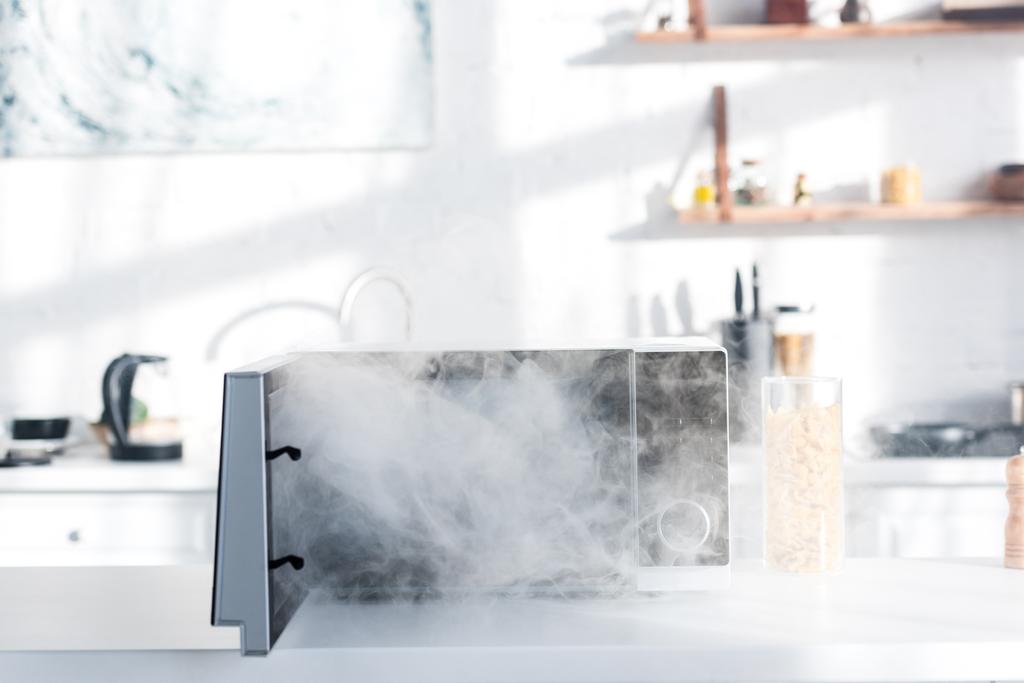Microwaves are an essential appliance in the modern kitchen. I often think I could live without it, until the moment I don’t have it and I realize how much I rely on hot food for meals They are a quick, convenient, and energy-efficient way to heat food and liquid. But how hot does a microwave get, and what happens inside when we cook our food?
In this blog post, we will take a closer look at microwave cooking and temperature to gain a better understanding of this everyday appliance.

How does a microwave work?
A microwave uses a magnetron tube to produce electromagnetic waves called microwaves that penetrate food and cause the water molecules to vibrate. This rapid movement creates friction, which generates heat and ultimately cooks the food. Microwaves do not have heating elements themselves, so the microwave itself does not heat up, but instead the microwaved food is the only thing that gets hot.
People often worry about the effect of microwaves on our body, but the door itself is a safety feature itself because it is specially designed to contain the power in the cooking cavity of the microwave. The FDA ruled that only a certain amount of electromagnetic radiation can leak from a microwave defined as 5 milliwatts per square centimeter which was determined not to be dangerous to humans.
Temperature in a Microwave
The maximum temperature a microwave can reach is around 212°F (100°C), the boiling point of water. However, the highest temperature inside the oven does not remain constant. When our food is heated in a microwave, the temperature can fluctuate, sometimes reaching higher levels than 212°F. This is because the food itself acts as a heat sink, absorbing the heat and slowing down the cooking process.
In general, the temperature inside a microwave oven does not get hot enough to cause harm to humans or cause a fire. However, certain containers, such as plastic containers and styrofoam, should not be used in the microwave, as they can melt or release harmful chemicals into the food in high temperatures.
Factors that affect a microwaves temperature
- Power level: The power level setting can affect the cooking time and temperature. A lower power level will result in longer cooking times and lower temperatures, while higher power levels will result in shorter cooking times and higher temperatures.
- The type of food: Different types of food absorb microwave energy differently, which can affect the cooking temperature. For example, dense foods such as meats may cook at a slower rate and at a lower temperature than lighter foods with high water content like vegetables.
- The size and shape of the food: The size and shape of different foods being cooked can also affect the cooking temperature. Larger, thicker foods may cook at a slower rate and at a lower temperature than smaller, thinner foods.
- The microwave itself: The age and condition of the microwave, as well as its wattage, can affect cooking temperature. Older microwaves may not heat as effectively as newer models, and microwaves with lower wattage may take longer to heat food to the same temperature as those with higher wattage.
- Altitude: Cooking in high altitudes can affect the temperature and cooking time as the pressure and temperature are different.
What is the wattage of your Microwave?
The wattage of a microwave refers to the amount of power it uses to generate heat. The wattage of a microwave is usually listed on the label on the back or front of the appliance or in the user manual.
In order to better understand the temperatures inside a microwave, it can be helpful to relate them to the cooking temperatures that you use in regular ovens.
Below we compare the microwave wattage to cooking temperatures in your conventional oven (in degrees Fahrenheit) to give a better idea of the heat your microwave in your oven:
| Microwave (watts of power) | Oven Temperatures (in degrees Fahrenheit) |
|---|---|
| 700-watt microwave | 350°F |
| 800-watt microwave | 450°F |
| 900-watt microwave | 525°F |
| 1000-watt microwave | 575°F |
| 1100-watt microwave | 625°F |
To determine the wattage of your microwave, you can check the label or the manual, or look up the model number online. Mine is listed on the label just inside the microwave door. The typical wattage of a microwave oven ranges from 600 to 1200 watts.
Cooking with a Microwave
When cooking with a microwave, it is important to use microwave-safe containers and to follow the instructions provided by the manufacturer. There are certain materials like metal that will explode if put in a microwave even after only a few seconds especially at a higher temperature. Be sure to remove silverware or foil coverings from food before you cook it in the microwave.
In addition, food items that have a higher amount of water content, such as fruits and vegetables, cook more evenly in the microwave than foods that are low in water content, such as meats and breads. Foods with lower water content will require intermediate stirring to make sure that the food is heated thoroughly.
A microwave is a safe and convenient appliance that can be used to cook food quickly and efficiently. While the internal temperature of the microwave does not reach high levels, it is important to use microwave-safe containers and to follow the instructions provided by the manufacturer to ensure safe and effective cooking. Whether you are looking for a quick snack or a full meal, a microwave oven is an indispensable tool for cooking food in the modern kitchen.
Have an old microwave that you need to get rid of? Find out how where you can dispose of an old microwave.
